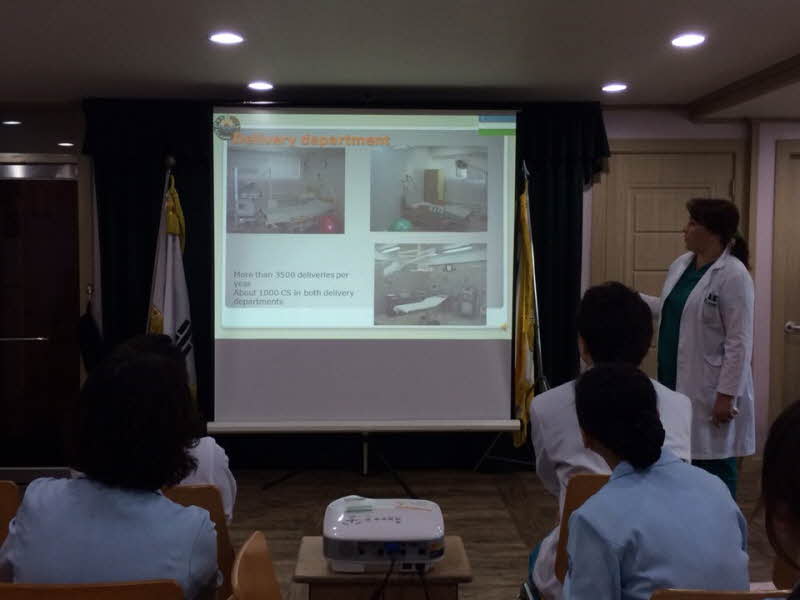News Letter
| Dr. Lola Nurmukhamedova Introduction to the REPUBLIC OF UZBEKISTAN | |
| Date : 2014-04-01 hit : 9022 | |
 Uzbekistan, officially the Republic of Uzbekistan is one of the independent states of CIS Commonwealth of Independent States. It is a doubly landlocked country in Central Asia, formerly part of the Soviet Union. It shares borders with Kazakhstanto the west and to the north, Kyrgyzstan and Tajikistanto the east, and Afghanistan and Turkmenistanto the south. Once part of the PersianSamanid and later Timuridempires, the region was conquered in the early 16th century by Uzbek nomads, who spoke an Eastern Turkic language. Most of Uzbekistan’s population today belong to the Uzbek ethnic group and speak the Uzbek language, one of the family of Turkic languages. Uzbekistan was incorporated into the Russian Empire in the 19th century and in 1924 became a constituent republic of the Soviet Union, known as the Uzbek Soviet Socialist Republic(Uzbek SSR). It has been an independent republic since December 1991. Uzbekistan has an area of 447,400 square kilometers (172,700 sq mi). It is the 56th largest country in the world by area and the 42nd by population. Uzbekistan stretches 1,425 kilometers (885 mi) from west to east and 930 kilometers (578 mi) from north to south. Among the CIS countries, it is the 5th largest by area and the 3rd largest by population. Uzbekistan is Central Asia`s most populous country. Its 27.7 million people (July 2007 estimate)[6]comprise nearly half the region`s total population. The population of Uzbekistan is very young: 34.1% of its people are younger than 14 (2008 estimate).[6]According to official sources, Uzbeks comprise a majority (80%) of the total population. Other ethnic groups include Russians 5.5%, Tajiks5%(official estimate and disputed), Kazakhs, Karakalpaks 2.5% and Tatars1.5% (1996 estimates).
SLIDE 3 Here You can see the satellite map of Uzbekistan
Uzbekistan`s economy relies mainly on commodity production, including cotton, gold, uranium, potassium, and natural gas. Despite the declared objective of transition to a market economy, Uzbekistan continues to maintain rigid economic controls, which often repel foreign investors. Uzbekistan is a dry, landlockedcountry; it is one of two doubly landlocked countries in the world, i.e., a country completely surrounded by landlocked countries – the other being Liechtenstein. Less than 10% of its territory is intensively cultivated irrigated land in river valleys and oases. The rest is vast desert (Kyzyl Kum) and mountains. The highest point in Uzbekistan is the Khazret Sultan, located at 4,643 meters (15,233 ft) above sea level, located in the southern part of the Gissar Rangein Surkhandarya Province, on the border with Tajikistan, just north-west of Dushanbe. The climatein the Republic of Uzbekistan is continental, with little precipitation expected annually (100–200 millimeters, or 3.9–7.9 inches). The average summer high temperaturetends to be 40 °C (104 °F), while the average winter low temperature is around −23 °C (−9 °F).[14] Major cities include Andijan, Bukhara, Samarkand, Namangan and the capital Tashkent. Uzbekistan is divided into twelve provinces, one autonomous republic Karakalpakistan Autonomous Republic, and one independent city. Religion Islam is by far the dominant religionin Uzbekistan, as Muslimsconstitute 90% of the population. Approximately 5-7% of the population are Christians. The next slide you can see several ancient cities of Uzbekistan, which constitute the Great Silk Road. SLIDE 4,5 These are Samarqand, Bukhara, Khiva. SLIDE 6 Also we have very beautiful mountain resorts not far from Tashkent city. Slide 7,8 The ministry of Health The head of health care administration is MoH, which is situated in the Tashkent city. Under the MoH there are 12 region’s health care departments of MoH and MoH of the Karakalpak republic. Slide9 Management of the reproductive health, women’s health and obstetrics covered by ObGyn specialized research centre with it’s 4 branches, Reproductive centre and 19 branches, Republic Perinatal centre and 8 branches, Republic screening centre and 12 branches , 290 maternity houses and delivery departments and 3125 rural ambulances. There are about 6 thousand gynecologists in Uzbekistan. Some information about medical statistic. SLIDE 10-12
Need to be revised Research Institute of Obstetrics and Gynecology was established in Tashkent on October 1, 1974. Creation of the institute coincided with the formation of modern science and medical knowledge, the organization of public health, the emergence of large centers of education and culture. The research Institute of Ob & Gyn became the first clinical and at the same time educational and research institution in Uzbekistan.
Last year Res Inst of Ob and Gyn was renamed the Republic Specialized Scientific-practical Medical Centre of Obstetrics and Gynecology. There are 4 branches of Our centre in the four regions of Uzb – Karakalpakistan, Qashka, Djizza, Nama. SLIDE 14 There are 16 dep-s and 10 lab-s in our centre SLIDE 15, 16
Dep-s Delivery – 2 del dep-s total 55 beds 2 operation rooms 12 delivery rooms More than 3500 deliveries annually About 1 thousand cesarean sections There are 3 antenatal care units with 85 beds. We cure all kind of pregnancy complications like preeclampsia, premature rupture of membranes, Intra Uterine Growth Retardation, habitual abortion, missed abortion, cervical insufficiency and others. There is also infertile couple department where we cure infertility caused by genital tract infections, hormonal disorders, endometriosis, tubal obstructions, male infertility. In assisted reproductive techniques we use only intrauterine insemination with husband or donor sperm. There are also 2 gynecology dep-s |
|
| Attachments | No Attachments |
|---|---|
| Prev. | 2014 FertiLink |
|---|---|
| Next. | Dr . BC Choi has vistited IVF NAMBA Clinic, a world renowned IVF Center in... |









